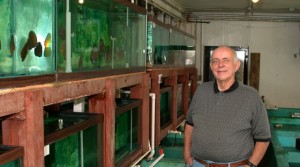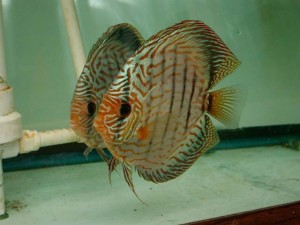Peter Thode’s discus hatchery burned down. Not once, but twice. And each time, he rebuilt it. “If you’re really into it, you don’t give up,” Thode said.
Thode is the owner of Gwynnbrook Farm, a largely Internet-order hatchery in the Northwest Baltimore suburb of Owings Mills, Maryland. I visited the hatchery, and wandered through the aisles while Thode was busy with a few walk-in customers. His fish all seemed well cared for. Healthy and alert, they hovered in their eye-level tanks, watching me as I watched them. Among the exquisitely beautiful discus strains were brilliant turquoise, Manaea Peru, red diamonds, flame marlboro, white snowflakes, and red spotted greens.
Along with discus, Thode also raises piranhas in his hatchery. He breeds these in several large cinder block tubs on the floor of the hatchery, providing them with trays of rounded stones to spawn in. From a friend in Germany, Thode acquired several altum angels that he hopes will breed. In addition to the hatchery, he maintains a 180 gallon reef tank in his house and a 10,000 gallon ornamental goldfish pond just outside his back door.
The hatchery is Thode’s labor of love, the culmination of a life-long fascination that began in childhood. Thode was born in Dresden, Germany, in 1932. When he was a child, he and the other neighborhood children would collect sticklebacks. A local woman would pay the children a small bounty for each fish, which she fed to her cat. Intrigued by the little fish, the young Thode kept some for a small aquarium he set up.
…a young man’s fancy lightly turns to…
He left Germany for Sweden in 1952. In that country, he met a young woman who would later become his bride. He was fascinated by the angel fish in the aquarium his future father-in-law kept. He found himself going to visit more and more often, as much to see the fish as to see the young woman.
In 1957, the couple moved to the United States. They saved their money until they could afford a house, which they bought in 1960. Gradually, Thode filled the basement with aquariums. Old refrigerator liners, also, became makeshift fish containers, each holding about 100 gallons of water. He soon acquired the angel fish he loved, along with various killifish and barbs. It wasn’t long, however, before the humidity from all the tanks soon became a problem.
“I put so many aquariums in that poor little house that I basically ruined it,” he said. “The drywall was so soft that you could push it in with your thumb.”
More tanks, more space
Eventually, Thode looked for larger quarters. He gutted the house and replaced all of the water-logged drywall. In 1972, he bought Gwynnbrook farms, the 10 acre farm where he and his wife now reside. He built the house they live in without any extra help. But before he moved out of his old house, he worked out an agreement with the owners of the property he was buying. In preparation for the move, they allowed him to begin constructing an outbuilding on the property to house all his fish tanks. Eventually, he expanded the structure to include his current hatchery.
To keep the hatchery warm, he converted an old furnace to burn used motor oil. Unfortunately, a malfunction in the boiler led to a fire that destroyed the hatchery. He rebuilt it, only to have it catch fire again several years later, when a florescent light overheated. Before he began breeding discuss, Thode had bred angel fish for his friend Merrill Cohen, the owner and founder of the Baltimore-based Aquarium Products Company. Cohen passed away a few years ago.
“He was a wonderful man,” Thode said. “He was the nicest person I ever met.” It was Cohen who provided Thode with his first discus. In 1975, Cohen surprised Thode with 12 wild-type discus he had brought back with him from an aquarium trade show in Seattle. Thode began breeding discus full time in 1982. Previously, he had worked as a service manager in the automobile business for 28 years. When the owners sold the company, he devoted himself to his discus and the cattle he raises on his 10 acre farm.
More than 25 years later, he’s still going strong, getting up at 5 am every day to take care of his charges. To keep his discus healthy, Thode changes 10 to 15 percent of their water daily. He begins with water from the tap, at a pH of 7.3. He adjusts the pH to 6.5, as many of his customers have difficulty maintaining their water at 6.0.
Filtration is provided by large Triton swimming pool filters, which circulate the water through beds of sand. The tanks are maintained by 7 separate filtration systems, he said. Should an outbreak of disease occur, it is limited to one system and won’t affect fish in the others. Windows and skylights keep the hatchery well lit. To keep sunlight from turning the water green, Thode keeps a mesh bag of maple leaves in each system. The leaves leach tannins, which tints the water just enough to prevent suspended algae blooms. He maintains the hatchery at about 82 to 84 degrees, heating it through steam pipes under the floor. Heat is provided by home heating oil and a furnace that Thode stokes with scrap lumber.
Feeding discus
Thode makes his own discuss food, from a such diverse ingredients as canned green beans, oatmeal, shrimp, turkey hearts, and turkey livers. It’s important to use the best ingredients possible, he said, to ensure that the fish will eat it. “If the fish don’t like it, I have to take it out the next day,” he said. “All it does is pollute the water.” Thode makes about 400 to 500 pounds of the food at a time. He doesn’t sell his discus food, but he does provide instructions on how to make it on his Web site, at http://www.discushatchery.com.
Soon after his discus spawn, he removes the eggs from the parents and hatches them in a solution of methylene blue. Discus are reputed to be good parents, he said. In fact, about 90 percent of discus are not good parents. “Parenting varies with the fish—like people,” he said. After the eggs hatch, he places the fry in little bowls. Thode lines the outer edge of the bowl with raw egg yolk, then dusts the raw yolk with powdered egg yolk before filling the bowl with water. About 3 to 5 days after the fry are free swimming, he feeds them newly hatched brine shrimp until they are large enough for other foods.
Thode explained that many people fail to get their discus to spawn because they over look the fish’s need for solitude when they’re ready to breed. Similarly, showing discuss fry to visitors may also spook the parents into eating the fry. When he plans to breed discus, Thode moves them to a corner of the hatchery that is closed off to visitors. “Animals will destroy their babies if they can’t take care of them,” he said. He explained that getting discus to spawn isn’t that difficult, if the fish are well fed, kept away from visitors, and are given water conditions they like. Many hobbyists know about these conditions but ignore them anyway, and then are disappointed when they fail, he said.
“There are no secrets to breeding discuss,” he said. “It’s all been written already. You just have to follow the instructions.”


